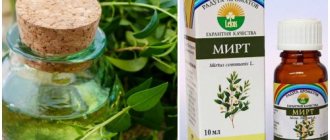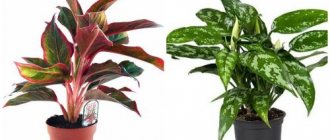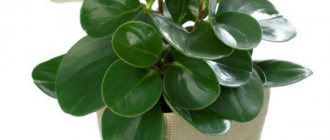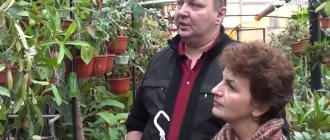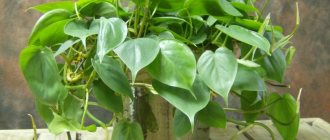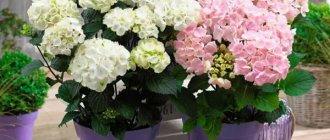Home » Flowers and plants » Indoor plants
Vladimir 05/01/2020
19599 Views
Succulents are fairly easy to care for at home. People from hot countries have an exotic and decorative appearance. It’s not scary to leave them without water when going on a long vacation or business trip. Succulents come in many varieties, allowing everyone to choose a flower to suit their taste.
Peculiarities
Succulents are plants with succulent leaves and stems; they belong to different families:
- Euphorbiaceae
- Cactaceae
- Liliaceae
- Crassulaceae
- Lastovnevye
- Aizoonaceae
- Kutrovye
- Agave
They are united by the same growth conditions
They prefer dry areas such as deserts. Succulents can also be found in roadside dust. They do not like excess moisture and rainy weather. She ruins them.
For many, it is enough to water twice a year. They make a reserve that is enough for full development. The leaves of the plant are covered with bloom. It performs a protective function from the scorching sun, protecting the leaves from burns.
The plant is native to the deserts of Africa, as well as the American continent. In Europe, for example, caustic sedum is also found in nature.
Mesembryanthemum
Mesembryanthemums are creeping or creeping succulents with recumbent and highly branched stems. The fleshy leaves may be round or spindle-shaped. They love light soil and good lighting. In the southern regions it is grown as a perennial, while cultivation in the middle zone is associated with certain difficulties. If you want this succulent to please you for more than one year, you will have to dig it up for the winter.
The former Latin name for this type of succulent was translated as “midday flower.” Inventing it, botanists appealed to the specific feature of plants of this group to open their flowers when the sun is high at its zenith. However, over time the name had to be changed, because later studies showed that among them there are species that bloom at other times of the day.
Care
Each type of succulent has its own rules for care.
However, there are general rules that must be followed when growing them at home.
Lighting
Lots of light is the most important condition for these plants.
They can easily withstand the scorching sun and thrive on south-facing windows. If it is impossible to meet these conditions, there is no need to breed them at home. Or provide artificial lighting.
There are varieties that can tolerate shade.
The most common of them:
- Schlumberger
- Sansenvieria
- Crassula
For these succulents, the lack of light slows down development. Because of the shade, their health weakens, they are more often attacked by pests and various diseases.
Tolerance to poor lighting is determined by color. Such plants have dark green leaves and trunks.
All species do not like sudden changes in living conditions. After the winter months, they need to be gradually accustomed to light. Otherwise, burns will appear on the leaves in the form of red spots.
Watering
Succulents require minimal watering. They will suffer from excess moisture, even to the point of death. Under natural conditions, a powerful root system is nourished by moisture extracted from the ground; in small pots this possibility is not available.
There is no need to spray the plants. Dry air is healthier for them than humid air.
Watering is stopped on rainy days and in winter. During the winter they can be watered no more than 2 times. The water should be at room temperature. Soft and settled is best.
Fertilizers
You need to fertilize once a month
Fertilizers with a high content of potassium and phosphorus are preferred. But there should be little nitrogen in them; its excess can only do harm. When fertilizing the soil, you need to follow the rule: it is better to underfeed than to overfeed.
Nitrogen makes the plant loose and watery. Many children appear, but they do not develop. The skin of the flower bursts, the wounds begin to rot. All this leads to the death of the succulent.
Temperature
In summer, flowers must be kept at high temperatures.
For the winter, you need to provide them with peace. Favorable conditions are maintained at 8 – 12 degrees.
Warmth stimulates plant growth, and lack of light causes them to stretch out. The result will be their ruined form. If it is not possible to reduce the temperature, then you need to provide them with artificial light. As a last resort, place it on a window, while covering the radiator with a screen.
Soil selection
Succulents require poor, infertile soil. Sand, turf and leaf soil mixed in equal proportions are suitable. Purchased substrates are unsuitable for them because they contain peat. If there is no choice, then be sure to mix sand into it.
Transfer
Small pots and flat bowls are suitable for succulents. It would be better if they were clay. Young plants are replanted every spring, adults once every 2 years.
Decorative mini-flower bed made of succulents
Drainage is laid at the bottom and a little earth is poured. Then the flower is planted and the remaining soil is added. There is no need to fill the container to the brim. You can lay pebbles on top. It will provide additional drainage and protect the root system from rotting.
Transplanted plants are not watered. Damaged roots need to take root. Otherwise, they will begin to rot and the plant itself will become sick.
When transplanting prickly varieties, they are wrapped in paper. This will protect your hands from injury.
Do cacti need to be watered?
Many people imagine cacti growing in the Sahara with virtually no water, but this is a misconception. Yes, they are able to survive in dry areas where little or infrequent water is available, but water is vital to them! At the same time, for their health and prosperity, excess moisture must be avoided.
In general, there are two types of cacti. Desert ones are what you think of when you hear the word “cactus.” They are native to the arid regions of North and South America and their surrounding islands.
But there are also jungle cacti. They grow in tropical forests and other habitats that may be completely unsuitable for desert habitats. Jungle cacti originate from the tropical jungles of Central and South America and primarily grow on trees or rocks. The most common are Schlumbergera, Rhipsalis, Epiphyllum, Hylocereus, Hatiora, Marniera.
Cacti don't need a lot of water, so you can grow them in tea or coffee cups without holes for drainage (use expanded clay at the bottom)
In the wild, the spines protect the cactus from herbivores and also help prevent water loss by reducing the surface area in direct contact with air. In the home, thorns can be a problem. When replanting a cactus, wrap it in several pages of glossy magazines. Then carefully move the plant from the old pot to the new one.
Be especially careful when dealing with glochidia. These small, jagged spines are irritating and difficult to see with the naked eye, making them very difficult to remove. If necessary, tape or tweezers can be used to remove glochidia.
Prickly pets are excellent house plants for both amateur and experienced gardeners. Very few plants require so little care and still add an element of special sculptural style to the interior.
Reproduction
Young plants
You can propagate succulents in 4 ways:
Seeds Required conditions:
- Planting material must be fresh. They need to be washed before planting.
- The substrate is sand and peat. Before planting, it must be disinfected by calcining it in the oven.
- The pot must have drainage holes
A drainage layer is placed at the bottom of the pot, and soil is poured on top . Before planting, it must be moistened by placing it in a tray with water. Next, you can sow the seeds.
Maintain the temperature around 22 degrees. Before the emergence of seedlings, sharp jumps should not be allowed. Plant shoots begin to appear after 20 days. You may have to wait longer, depending on the quality of the seeds.
The plant should be replanted no earlier than after 6 months. After diving, young succulents need to be shaded. This will help them quickly adapt to new conditions.
Cuttings To plant a new plant, the cuttings must be healthy and undamaged. After the cut, you need to put it on the window so that the cut can air for 2 - 3 days. Then it is planted in a pot.
Do not place succulent cuttings in water. They will begin to rot in it and will not take root.
The stems and leaves take root in about 14 days. You need to water regularly as the substrate dries out.
Leaf The leaf of the plant should be placed in a pot with loosened soil. Lightly press it into the ground. Next, leave it for two weeks. It will take root on its own and give birth to children.
Types of succulents that can be propagated from leaves. These include:
- Crassula
- Kalanchoe
- Sedum
- Pachyphytum
Vegetatively Some succulents grow babies on their leaves, already with roots, for example, Kalanchoe. All that remains is to collect them and plant them in the soil.
Other types of plants produce babies, for example, haworthia and aloe . They are carefully separated from the mother plant and planted.
Creeping varieties of succulents, such as delosperma, can be propagated by layering. The stem of the plant is dug in, after the roots appear, it is separated and transplanted into a separate pot.
How quickly do succulents grow at home?
The process of growing succulents is quite long and requires a lot of patience. The types of succulents also affect seed germination. For some plant species, a month is enough for the first shoots to appear, while others grow within three or more months.
If the seeds do not hatch through the soil for a long time, there is no need to despair. Every day you need not to be lazy, pay attention to fresh crops, periodically ventilate and water the soil.
Diseases and pests
Dying succulent
Succulents can be attacked by pests such as:
- Thrips
- Chervets
- Ticks
Insecticides rid plants of them. They can be purchased at a flower shop. Spraying the plant should be carried out following the instructions on the package.
Rot is very dangerous for these plants. It occurs due to a number of reasons:
- Poor or no drainage
- Overwatering
- Cold or hot, sudden temperature changes are more dangerous
It is almost impossible to save a plant infected with rot . The only way to remove rotten roots and part of the stem. Plant in new soil. This method does not provide any guarantee for the survival of the flower.
Another problem is mold. It appears on the leaves of the succulent. If it is detected, you need to remove all moldy areas of the succulent. This will stop the spread of the disease. It is recommended to replant and feed the plant.
It is easier to prevent a plant from getting sick than to treat it later.
To do this, you can take a number of preventive measures:
- Do not water frequently; the soil should be allowed to dry.
- Add coal to the soil when transplanting a flower.
- Provide sufficient bright light.
- Use drainage.
- During the dormant period of the succulent, follow the rules of care.
- Replant the plant strictly in the spring.
Young (tenacious)
The youngster received its popular name – “tenacious” – for its ability to survive in the most difficult conditions. Widely distributed in mountainous areas. In the European part of Russia, there is only one species of juvenile - Caucasian juvenile. It hybridizes equally easily both in culture and in natural conditions, so it can be difficult even for a specialist to determine exactly which species a particular specimen belongs to. Moreover, representatives of the same species, depending on growth conditions, time of year and even stage of development, can be completely different from each other.
The list of succulents, like Scheherazade's fairy tales, can be continued endlessly. In the first part of the article, we only slightly lifted the veil hiding the secrets of these plants. Read the continuation in our next materials.
Medicinal properties
Succulents have beneficial properties
Some succulents have medicinal properties:
- The most famous is aloe vera; it can cure viral and fungal diseases. It is believed that it fights malignant tumors.
- And its closest relative, aloe vera, is actively used in cosmetics.
- Kalanchoe - relieves pain after burns, treats skin diseases, relieves itching.
- Agave – applied to bruised areas and hematomas, relieves toothache. You need to be careful with it, the plant can cause poisoning, and its juice can burn the skin.
- Prickly pear cactus has a diuretic effect.
- Crassula helps with colds.
- Sansiviera relieves headaches and helps with otitis media. She is being treated for scabies. This succulent is a natural energy booster.
- Sedum heals wounds and hematomas. It is used to remove warts. It removes small external tumors. Stops bleeding.
How to determine the type of succulent?
Its flowers will help you determine the type of succulent.
- Kalanchoe - usually flowers have 4 petals.
- Agave , aloe and haworthia - 6 petals each.
- Sedum - small (up to 2 cm) flowers in the shape of a star.
- Crassula - flowers with five petals and ten stamens.
- Aeonium – 5 petals and 5 stamens.
- The young may have more than 5 petals and stamens.
The magic of succulents
Succulents have positive magic
In addition to beauty and medicinal properties, people attribute some succulents with magical powers:
- Crassula attracts wealth into the house if placed on the desktop. When standing on a window, it is believed to attract good luck for its owner.
- Zamioculcas is responsible for the money in the house.
- Italians believe that these plants repel lightning. In order to protect the house, they are grown on roofs.
Cacti or other succulents: what to choose
Cacti seem to take over everything: they're in the trendy corner store, on the table in your favorite cafe, on the windowsill of a friend's house. The reasons for their popularity are easy care (although you still need to look after them!) and variety (they come, for example, hairy, columnar, with “bunny ears,” soft, and so on).
Cactus does not necessarily mean prickly. Many succulents that do not belong to the cactus family (for example, some milkweeds or agaves) have spines. In addition, there are cacti without thorns at all (for example, most laphophoras). All cacti are succulents, but not all succulents are cacti.
A true cactus can be identified by the presence of areoles: spines, glochidia (serrated spines), branches and flowers grow from them. All cacti have them, and only them. Other succulents lack areoles (they usually look like small, furry bumps).
Decorative compositions
You can create various mixes from succulents. They are very beautiful and will become an exotic addition to the interior.
Types of compositions:
Florarium This is a decorative composition of a mix of plants that are planted in a glass container with a narrowed neck. Its advantage is that optimal microconditions are created inside.
Plant terrarium Features a wide neck. To create it, plants are planted in bowls, cups and other containers.
For compositions, different types of succulents and various decorative items are used. You can give free rein to your imagination when creating. To learn in detail how plants are arranged into mini-gardens, we suggest watching the video:
Changes in the internal structure
Along with storage organs, succulents have developed other devices for retaining liquid:
- the cell sap of succulents contains many colloidal substances that prevent the rapid evaporation of moisture;
- loose aquiferous tissue is developed, characterized by large cells containing substances that promote water retention.
Special metabolism - CAM metabolism
In the process of adapting to environmental conditions, succulents have developed a special metabolism. If in ordinary plants photosynthesis occurs during the day, then in most succulents the stomata are closed during the day, so the synthesis of nutrients occurs at night (this metabolism has received a special name: CAM metabolism or acid metabolism of Crasulas):
- At night, carbon dioxide CO2 enters the plant, during the assimilation of which organic acids are formed.
- During the day, acids break down, releasing CO2, which reacts with water to form carbohydrates and oxygen, released by plants at night.
Thus, by reducing respiration, succulents reduce moisture loss during the hottest hours.
Signs of succulent crops
- Succulents have the same origins. Almost all of them grow in arid African countries. You can meet southern perennials in desert areas. Also, some species grow in rocky and rocky areas.
- Almost all succulent plants are long-lived and can survive for a hundred years or more in their natural habitat. It’s not for nothing that the same aloe is called “agave”. At home, succulents will not live that long, but with good care their age can reach thirty or even fifty years.
- Leaf succulents are characterized by dense, succulent leaves that can hold liquid for a very long time. This is why succulent crops can survive even in desert conditions and complete drought.
- Indoor succulent flowers are easy to care for. Also, these plants can be easily propagated in different ways: by cuttings, leaf and seed methods.
Air humidity
Succulent crops love dry air. Too humid air can cause rot. Therefore, experienced gardeners do not recommend spraying succulents. Although on particularly hot days, some varieties of succulents can be given a warm shower. If the leaf plates become dirty or dusty, you can wipe the leaves with a damp cloth or rag.
From time to time, the flowers should be ventilated; to do this, you can open a window or take the flower pot out onto the loggia or veranda. Drafts and temperature changes should be avoided. If a plant has been in a hot room for a long time and then suddenly moved to a cool place, it may get sick.
Lighting
One of the conditions for proper care is proper lighting for succulents. Succulent plants love the sun very much, so you need to place the pot on the windowsill in such a way that the plant receives a lot of sunlight. Succulents such as cacti do not need to be shaded. But the same Crassula and aloe should be protected from direct burning rays of the sun, so as not to burn the leaves.
In winter, succulent flowers may not have enough light. For such situations, a special lamp for succulents will come in handy. Some novice gardeners wonder why succulents stretch upward. This happens because they don't have enough light.
It is important to know! A phytolamp for succulents is an excellent alternative to the sun. The lighting unit must be positioned in such a way that it is not too close to the flower, but the light falls directly on the flower.
Pot
Succulent crops are planted in various containers: flowerpots, pots, flowerpots, containers. The main thing is to choose the right pot for growing exotic crops. There are different shapes, sizes and types of flower pots.
- Breeding mini-flowers can be done in long pots or shallow containers.
- For hanging flowers you will need hanging vases or pots.
- For tree-like plants, you need to choose large, deep, stable pots.
The size of the pot depends on the size of the succulent's root system.
It is better to buy clay or ceramic pots; they allow air and moisture to pass through the walls well.
There should be drainage holes at the bottom of any container through which excess moisture will flow out.
Transfer
It is recommended to replant young succulents every year. Adult and old specimens should not be replanted often. It is enough to replant once every three or five years. You can plant or replant a flower as planned in the spring season. Plants for which the previous pot has become too small also need to be replanted. Urgent replanting is needed in cases where the plant rots, the soil begins to turn sour, or is not suitable for succulents, if the pot cracks or falls under the weight of the flower.
Flower replanting should be done carefully so as not to damage the roots and other parts of the plants. The best way to replant a crop is by transshipment. Carefully remove the flower along with the earthen lump and place it in a new container. In some cases, it is necessary to shake off the soil from the roots and inspect them; damaged and rotten roots should be cut off from healthy roots.
Attention! A thorny or poisonous succulent must be replanted while wearing protective gloves.
